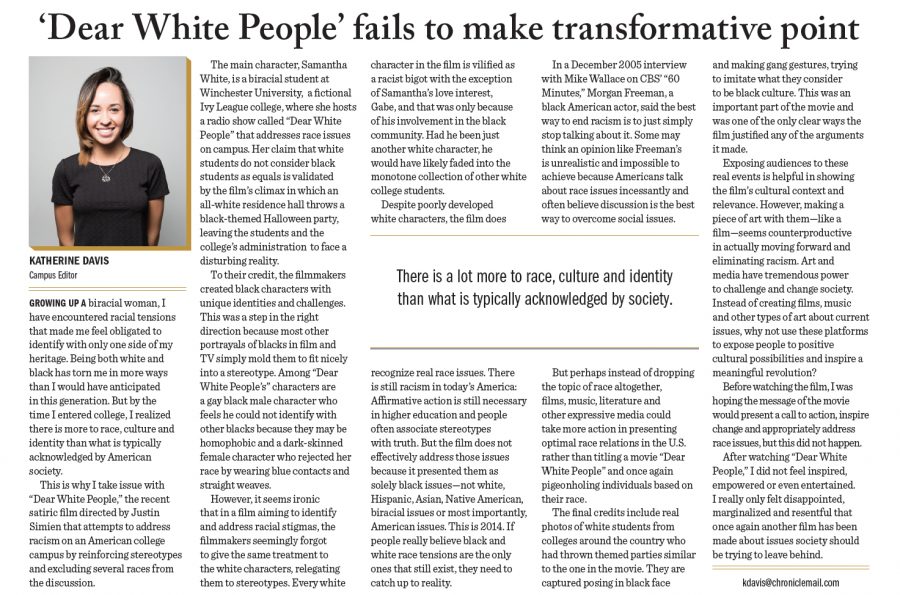‘Dear White People’ fails to make transformative point
November 3, 2014
Growing up a biracial woman, I have encountered racial tensions that made me feel obligated to identify with only one side of my heritage. Being both white and black has torn me in more ways than I would have anticipated in this generation. But by the time I entered college, I realized there is more to race, culture and identity than what is typically acknowledged by American society.
This is why I take issue with “Dear White People,” the recent satiric film directed by Justin Simien that attempts to address racism on an American college campus by reinforcing stereotypes and excluding several races from the discussion.
The main character, Samantha White, is a biracial student at Winchester University, a fictional Ivy League college, where she hosts a radio show called “Dear White People” that addresses race issues on campus. Her claim that white students do not consider black students as equals is validated by the film’s climax in which an all-white residence hall throws a black-themed Halloween party, leaving the students and the college’s administration to face a disturbing reality.
To their credit, the filmmakers created black characters with unique identities and challenges. This was a step in the right direction because most other portrayals of blacks in film and TV simply mold them to fit nicely into a stereotype. Among “Dear White People’s” characters are a gay black male character who feels he could not identify with other blacks because they may be homophobic and a dark-skinned female character who rejected her race by wearing blue contacts and straight weaves.
However, it seems ironic that in a film aiming to identify and address racial stigmas, the filmmakers seemingly forgot to give the same treatment to the white characters, relegating them to stereotypes. Every white character in the film is vilified as a racist bigot with the exception of Samantha’s love interest, Gabe, and that was only because of his involvement in the black community. Had he been just another white character, he would have likely faded into the monotone collection of other white college students.
Despite poorly developed white characters, the film does recognize real race issues. There is still racism in today’s America: Affirmative action is still necessary in higher education and people often associate stereotypes with truth. But the film does not effectively address those issues because it presented them as solely black issues—not white, Hispanic, Asian, Native American, biracial issues or most importantly, American issues. This is 2014. If people really believe black and white race tensions are the only ones that still exist, they need to catch up to reality.
In a December 2005 interview with Mike Wallace on CBS’ “60 Minutes,” Morgan Freeman, a black American actor, said the best way to end racism is to just simply stop talking about it. Some may think an opinion like Freeman’s is unrealistic and impossible to achieve because Americans talk about race issues incessantly and often believe discussion is the best way to overcome social issues.
But perhaps instead of dropping the topic of race altogether, films, music, literature and other expressive media could take more action in presenting optimal race relations in the U.S. rather than titling a movie “Dear White People” and once again pigeonholing individuals based on their race.
The final credits include real photos of white students from colleges around the country who had thrown themed parties similar to the one in the movie. They are captured posing in black face and making gang gestures, trying to imitate what they consider to be black culture. This was an important part of the movie and was one of the only clear ways the film justified any of the arguments it made.
Exposing audiences to these real events is helpful in showing the film’s cultural context and relevance. However, making a piece of art with them—like a film—seems counterproductive in actually moving forward and eliminating racism. Art and media have tremendous power to challenge and change society. Instead of creating films, music and other types of art about current issues, why not use these platforms to expose people to positive cultural possibilities and inspire a meaningful revolution?
Before watching the film, I was hoping the message of the movie would present a call to action, inspire change and appropriately address race issues, but this did not happen.
After watching “Dear White People,” I did not feel inspired, empowered or even entertained. I really only felt disappointed, marginalized and resentful that once again another film has been made about issues society should be trying to leave behind.








